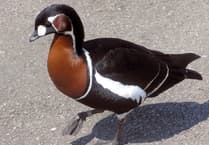Having been out of the country for most of March I have had to rely on the Tice’s Meadow Nature Reserve Facebook site for news of the reserve.
I have particularly enjoyed the written and pictorial contributions of Colin Varndell, the former for its knowledge and sardonic wit, the latter for the sheer quality of the pictures: highly recommended.
Thanks to social media input I have learned two rare species that demonstrate the great joys of birding - namely variation in colour, form and behaviour - were spotted last month at the reserve.
The two species are the Spoonbill and the Black Redstart. The former has an enormous beak and is a large wading bird almost a metre tall while the latter is a robin-sized bird, which weighs about two thirds of an ounce.
The Spoonbill is an unmistakable bird. It is either seen in fight, with its long neck extended forward like a swan and its legs trailing behind, or wading in shallow water with long slow strides as it sweeps its long flattened bill through the water, collecting invertebrates.
Having bred in England until 17th century the bird made a welcome return as a breeding species at the end of the last century.

They now breed regularly in small colonies in East Anglia but the numbers of this migratory specials are still very low with about 29 pairs according to the BTO.
The Black Redstart is also seen on passage, and is a rare breeder, about 50 pairs a year. It is a bird of rocks and mountains but has adapted to urban environments.
It was so prevalent in London in the post war years that it became known as the “bomb site bird”.
It is a grey/black with the eponymous red tail which constantly flicks, highlighting the colour.
Another bird mentioned in Colin’s despatches was the Dunnock. This little brown job, which is mainly brown and grey, is a very common bird at Tice’s.
Don’t be deceived by their unassuming plumage, though, as they have a sex life which would shame Jilly Cooper.
They indulge in virtually every mating strategy possible and monogamy is out of the question for most.
All this jockeying is an attempt to get their genes into the next generation. Natural selection at work.
In the one female, two males scenario, the female adopts a very clever strategy. She will mate with one of the males, but when the other appears he will peck away at her rear until she ejects the sperm from the first male, before the second male mates with her.
Therefore, both males think they are the father of the brood, consequently both feed the young, increasing their chance of survival dramatically. At the height of the mating season this can occur up to 100 times per day.
This reproductive behaviour was only discovered in the 1990s, which just goes to show how much more we have to learn and we shouldn’t dismiss these little brown jobs as boring. By Alan Wynde






